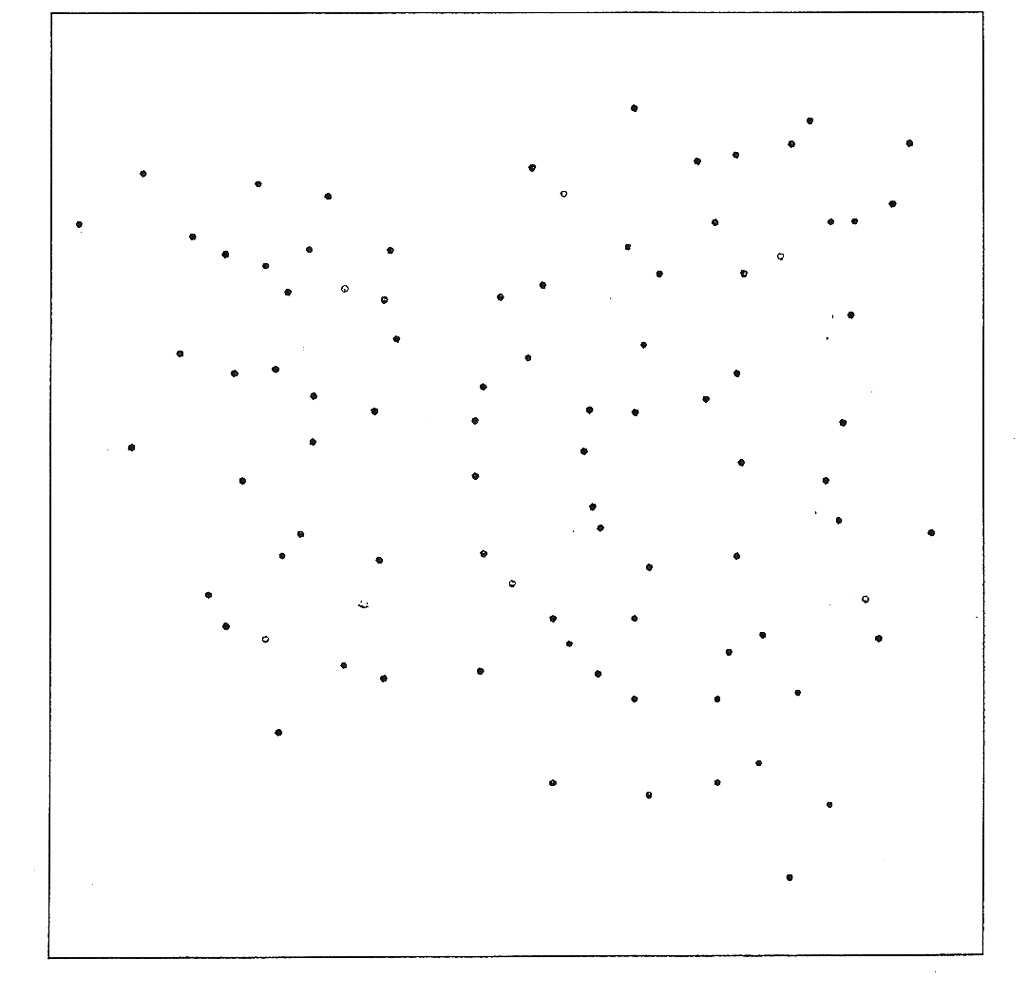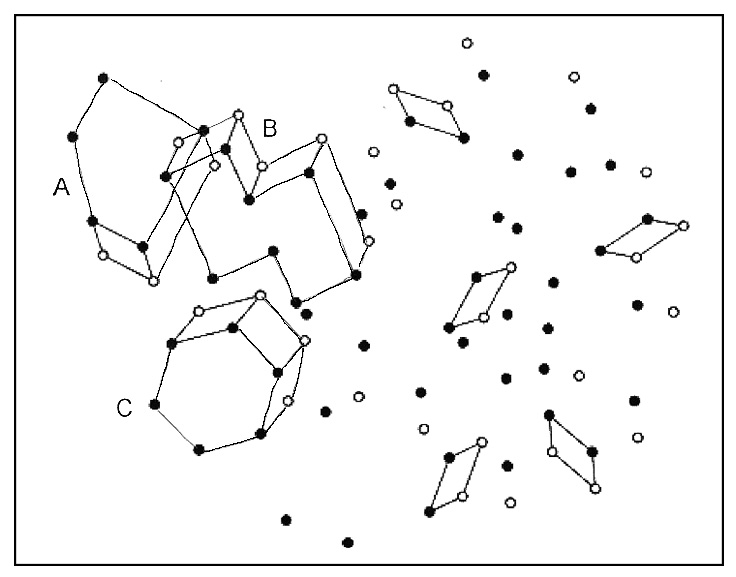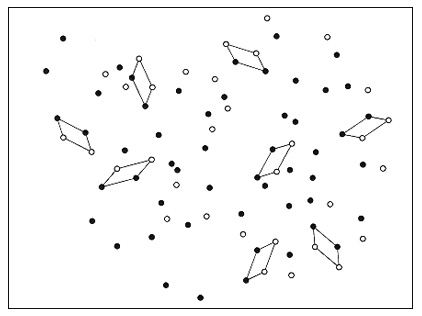The Ghost in My Brain (28 page)
Read The Ghost in My Brain Online
Authors: Clark Elliott

DOTS PUZZLES
Find all instances of the appropriate three shapes in each of the following two puzzles. Every dot will be used.
2D PAGE OF DOTS OVERLAID

Key

Puzzle
Â
3D PAGE OF DOTS OVERLAID

Key

Puzzle
I would like to thank the following people who were essential in bringing this manuscript to life. In chronological order: Donalee Markus, and Deborah Zelinsky, who agreed to painstakingly verify all of the notes on my recovery; my good friend the writer Pamela Janis, the catalyst who turned a collection of notes into a real book and has been the best champion for it from the start; Leslie Breed, who graciously gave her time early in this project; Howard Yoon, whose reputation as one of the finest agents in the business does not do justice to the breadth of his kindness and compassion as a human being; Melanie Tortoroli, who blessed us with her essential editing gifts and global patience in managing so many aspects of this large project; my daughter Nell Elliott, whose insight and skill are everywhere present through the six thousand edits she made in the manuscript, and the structural design she suggested; our copy editor, Michael Burke, who painstakingly cleaned up the text throughout with the logic and precision of
a scientist; Georgia Bodnar, who managed all the art; and all of the other professionals at Viking who tolerated me as an academic used to fighting over every comma. I'd especially like to thank all of those in the DePaul community who were so supportive, including, but not limited to, my compassionate deans Helmut Epp, and David Miller, and my colleagues Gary Andrus, Adam Steele, and Greg Brewster.
The page numbers in this index refer to the printed version of this book. To find the corresponding locations in the text of this digital version, please use the “search” function on your e-reader. Note that not all terms may be searchable.
3D
dot exercises, 232â33, 235â37, 241
hearing, 158, 258â59
spatial world, 67, 223, 250, 255, 259
vision/visual world, 67, 121, 158, 255, 259
action initiation, 6, 9, 26, 61â63, 66â67, 79, 105, 146, 268, 278
arithmetic, 101, 127, 142â43, 157, 197, 224
attention difficulties, xx, 82, 228â29, 239â41, 245, 270, 278, 283, 295
audio
error correction, 177
input, 146â47, 159, 198â99
processing, 163â70, 259
slowness, 163â70, 176
aural processing, 91â93, 117, 132, 137â38, 142â43, 149, 164, 174, 272â73
balance, 54, 60, 72, 115, 244
and eyeglasses, xvii, 264â65, 269â70
and the eyes, xvi, 85â87, 89â90, 104, 158, 250
and hearing, 91â93
improvement in, 208, 223, 294â95
loss of, 4, 27, 31, 39, 45, 47, 49, 79, 86â88, 90, 92, 94, 119, 126, 183, 189, 296
system of, 84â89, 93â94, 119, 183
techniques for, 7, 14, 41, 88, 91â92, 98, 177, 184, 209, 279
and visual system, 79, 84â87, 89â92, 147
body-sense cognition, 183â85, 244
body-versus-surroundings sense, 88â91
brain
analogical processing of, 130â32, 138, 144
computational powers of, xix, xxii, 10â13, 109, 149, 163, 224
and conceptual information, 96â100
fatigue, 14, 17â18, 65, 67, 76, 78, 87, 97â98, 103â4, 119, 121â22, 140, 143â45, 154â55, 183, 199, 230, 248, 271
healthy/normal, 75â76, 96, 130, 132, 139, 151, 162
processing, 213, 244â46, 249
rebuilding of, xxiv, 13, 34
reconfiguring of, xiii, 262â63
recovery, 57â61, 65, 86, 91, 108, 215â16, 226, 229, 248
resources, 74, 79, 133, 135, 139â40, 142, 149, 239, 241
rest, 6â7, 18, 58â61, 65, 86, 99â100, 104, 106â7, 150, 177, 187, 267
seizures, xvii, 185â88, 215, 280
stress, 89, 117, 193â96, 208, 215, 252, 267
systems, 11â13, 55, 58, 132, 222
brain-body relationship, xvâxvi, xxiiâxxiii, 181â83, 188â91, 257
brain-body states, 55, 245
brain-body system, xvii, 110, 191
brain injury
definition of, 10
diagnosing of, xiiâxiii, 44â47, 192â93
life-altering changes from, 10, 53, 71â72, 84, 114, 159, 179â80, 193, 200, 209, 297
and permanent damage, 34, 48, 54â55, 61, 193â95
brain plasticity, 13, 130, 137, 211
and brain recovery, xiii
and cognitive treatment, xxiii
explanation of, xii, xx
and eyeglasses, 288
and eyesight, 247, 269, 277
principles of, 246â47
research in, xx, 200â201, 294
Brain That Changes Itself: Stories of Personal Triumph from the Frontiers of Brain Science
,
The
(Doidge), 201
calendars, 8, 115, 120â24
car accident, xi, xv, 3, 19â35, 39, 44, 84, 86, 180, 188, 229, 295
causality, concept of, 120
certainty, lack of, 67â69, 77, 151
Charles Bonnet syndrome, 264
children, 6, 37, 52â54, 58, 130â38, 141, 196, 224.
See also
parenting;
specific names
cognition, xviii, xxii, 55, 84, 109, 130, 140â41, 180, 193â94, 266
cognitive
adaptability, xiii, 137
concepts, 140â41
difficulties, xi, xxii, 13, 15, 17, 20â35, 39â42, 45â49, 55â57, 69â71, 78, 94, 101, 109, 144â45, 152, 165, 184â85, 193, 209, 230, 240, 250, 255
disinhibition, 37
functions, 61, 69â70, 255
improvement, xv, 215â16, 222â24, 241, 262â63, 267, 269â71, 275â76, 285
input, 76, 154
interference, 148â49, 152
overload, 158â59, 177
patterns, 130
processing, 144
resources, 130, 142, 165, 177
rest, 7, 58â60
restructuring, xxiâxxii, 201, 205, 226â27, 241
science, 73, 110, 164
slowing, 6, 24, 29â30, 38, 45â46, 64, 79, 81, 125â28, 130, 207â8, 256, 297
stress, 47, 181
color, xvi, 11, 29, 97â98, 138, 148â49, 177, 183, 228, 233â35, 241, 243, 246
communication
difficulties with, 34, 81â82, 155, 166â70, 198, 283
improvement in, 223
See also
speech
computers, 10â11, 13, 36, 52, 73â75, 80, 110â12, 126, 194
concussion
diagnosing of, xx, 34, 40, 43, 69, 105, 193, 231
explanation of, 10, 34
serious/life-changing nature of, xx
simulation of, 13
typical symptoms of, 43, 46â47, 57, 64, 69, 85, 193, 295
concussives
and feeling nonhuman, xxiâxxiii, 61, 71â72, 109, 195, 219, 278
need rest, 58
shared experiences of, xxiâxxii, 46, 48, 72, 117, 124, 178, 219
support system for, 51â54
Conroy, John, 178
creativity, 36â37, 169, 178, 291, 293
daemons (thought processes), 73â83, 118, 133â37, 141â42, 146â47, 149, 168
decision making, 28, 57â58, 63â70, 72, 159â60, 295
DePaul University, xxiii, 3, 6, 19, 22, 31, 37, 48, 51â52, 88, 108, 231, 295.
See also
teaching
Descartes, René, xxiii, 111
directional sense, 6, 17, 22, 25, 100â2, 139, 166, 279, 295
DNA, 12
Doidge, Norman, 201
Dolly Zoom Effect, 5, 15
dreams, 101â4, 163, 265, 273, 279â80
ears, xvii, 196, 198â99, 217â19, 224, 262, 284, 296â97.
See also
audio; hearing; noise, sensitivity to
Elliott, Erin (daughter), 53, 60â61, 143â45, 155, 196â200, 206, 209â11, 275, 278â79
Elliott, Lucy (daughter), 53â54, 142â43, 275, 279
Elliott, Nell (daughter), 53â54, 142â43, 153â55, 197, 279
Elliott, Paul (son), 54, 142, 145, 196, 199, 275, 279
Elliott, Peter (son), 54, 142â43, 279
Elliott, Qianwei (wife), 53, 144, 151â55, 196, 200, 273, 275, 279
Elliott, Will (brother), 125â26
emotion, 184, 224, 245, 261, 267
emotional difficulties, xx, 60, 72, 83, 94, 178, 180
error correction, 79, 81, 165, 167, 176, 183
eyeglasses, xxiv, 241, 248
challenges of, 264â76
and cognitive improvement, xv, xviiâxviii, 267, 269â71, 275â76, 281
and colored lenses, 208, 259
and improved hearing, 216â22, 264
Phase I, 215, 263â72, 278, 281
Phase II, 226, 270â78, 281, 284â85, 291
Phase III, 276â78, 280â86, 291
Phase IV, 286â92
Phase V, 292, 294
Phase VI, 292â94
and prisms, 215, 250â52, 259â62, 269â70, 276â77, 282, 294
and regression, 277â80, 282
eyes, 102â3, 117â18, 149, 182, 207, 224
aiming system of, 237, 255â56, 269â70
and axons, 243, 245â47, 260
and balance, 85â87
and the brain, xvi, 213, 245â47, 255, 259â60, 262
focusing of, 38, 91, 139, 158, 237, 255â56, 260, 263, 269â72, 277, 284â86, 290â92
and light, 159, 243, 245â47
and music, 217â19, 221â22
movement of, 139, 158, 245, 253, 260, 269, 278
and non-image-forming retinal signals, xvi, 242â45, 248, 250, 258, 288
optic nerves of, 243, 245â46
and recovery exercises, 229, 237
and retinal processing, 213, 217, 242â48, 250, 255, 258, 260â63, 280, 288
See also
eyeglasses; vision; visual
fatigue, xx, 8, 25â27, 41, 104, 147, 190
from conversation, 81, 167â69, 198â99
and eyeglasses, 264, 268, 278
from eyesight difficulties, 253, 255
improvement in, 241, 281, 287
normal, 268, 271
from reading, 36
and recovery work, 215, 241, 275â76
from small tasks, 279â80
of visual systems, 92, 94, 172, 184
filters
cognitive, 144, 172, 237
exercises for, 237
and the eyes, 245â46, 258, 261
importance of, 76
loss of, 6, 37, 46, 76, 78, 99, 129, 144, 147, 158, 165, 172, 176â77, 185, 193, 199, 206, 297
and spoken dialogue, 129, 165, 176â77, 198â200
of visual data, 37, 96, 99, 147
See also
sensory: filters
Folstein Mini-Mental State Examination
, 44
Gallwey, Timothy, 189â90
geometric line drawings/shapes, xi, 185â86, 206â7, 229, 231â39
geometry, 128, 133, 139, 146, 183â85
of cognition, 231â39
difficulty with, 5, 9, 23, 40â41, 77, 90, 95, 155
and time, 120â22
triggers symptoms, 157, 186â87, 207â8
God, 107â9, 111â12, 195, 224
guilt, 78â83, 162
handicap parking, 100
handwriting/writing, 36â38, 279, 283â84
hearing, xvii, 84, 109
difficulties with, 278â79, 283, 292
improvement in, 217â22, 224,
264, 271
and pain, 159, 177, 296â97
and phonosensitivity, 29â30
and visual/spatial systems, 164, 244, 258
See also
audio; aural processing; ears; sound
Heather (professional organizer), 200â1, 225
hemispatial neglect, xxii, 137, 144
high-functioning people, xii, 75, 127, 178, 228, 236, 240â41
homeodynamics, 244, 261
hospital, 21, 28, 33â35, 39â42, 54, 70, 192
house rebuilding project, 26, 37, 53, 95â100, 157, 200
human mind, xxiiâxxiii, 10, 12â14, 21, 31, 83, 103, 110â11
humor, 156, 159â62, 169â70, 265, 293
ideaesthesia, 144, 148
Inner Game of Tenns
,
The
(Gallwey), 189â90
itching, 188â89
Jake (friend), 54, 63, 66, 79â82, 101, 146â55, 159â62, 178
Kowar, Dr. Lisa, 287â90
Lakoff, George, 114â15
left and right sides
concept of, 6, 16, 24, 137â38, 140â41, 184, 249, 252, 268, 271
and eyeglasses, 264, 267, 269â71, 277, 283, 289â93
and the eyes, 256â58, 269
letting go, 140, 142, 194â96, 200, 274
life after death, 109â11
light
bent left versus right, 251â52, 262, 277
and the brain, 245â47
and eyeglasses, 213, 250â52, 259, 261â63, 269â70, 276â77
and retinal processing, 213, 243, 245â46, 258, 262â63, 280
sensitivity to, 31, 159
line-drawing exercises, xi, 206â8, 228â39, 241
lines, making sense of, 185â88, 263
linguistics, 142â44, 152, 154â55, 167.
See also
communication; speech
logic, 67â68, 82, 121â22, 130, 144, 184, 190, 271, 294
Markus, Dr. Donalee, 126, 297
background/description of, 201, 205â6, 208â9
cognitive puzzles of, xiiâxiii, xxiv, 130, 205â6, 225â26, 241
diagnostic tests of, xi, 206â9
exercises of, xii, 228â41, 270, 275, 278
first meeting with, 205â9
recovery plan of, xiâxiii, 209â12, 215â16, 227â31, 241, 262â63, 294
and Dr. Zelinsky, xv, 212, 215, 267, 282
Martha (Zelinsky's assistant), 214â15, 249â50, 252â54, 257, 286â87
medical community, xi, xvii, xx, xxiiiâxxiv, 192â94, 209â10, 248
meditation, 7, 88, 106â7, 157, 295
memory, 111, 119, 151â55, 164, 169, 244
capacity/size of, 11â12
improvement in, 222, 224, 266â67
loss of, xii, 13, 70, 99â100, 113â14, 266, 274, 276
and planning, 121â22
and problem solving, 131, 142
and wearing glasses, 218, 266â67, 271, 274, 276
“working,” 131, 142, 218, 222
metacognitive voice, 126â29
metadialogue, 229
metaphor, 67, 114â17
mild traumatic brain injury (MTBI), xii, 10
Miller, Dr., 123
Mind-Eye Connection, The, 213â14, 286, 294.
See also
Zelinsky, Dr. Deborah
motion sickness, 31, 86â87, 102.
See also
nausea
motor function
and brain seizures, 188, 215
and cognitive processing, xvi
and cognitive stress, 45â47
and eyeglasses, xvii, 265, 267â68, 271, 279
and the eyes, 243â44, 250, 252, 261
improvement in, 223
loss of, xi, xxii, 14â17, 23â24, 26, 31, 33, 39â40, 49, 61â64, 66â69, 91, 99, 152, 177â78, 193, 195, 207â9
and recovery exercises, 229, 233, 238â39
slowing of, 6â9, 24, 45â46, 66, 98, 125â26, 175â76, 296
and spatial sense, 61â62
and taking tests, xi, 45â47, 207â9
See also
balance
multitasking
causes fatigue, 167
difficulty with, xxi, 31, 38, 57, 78, 120, 158â59, 164â65, 198â99, 262
improvement in, 295
muscles, 26, 28, 62, 136, 284
extraocular, 85, 253
and fatigue, 187
knotted up, 158, 207, 267â68
motor control of, 238, 257
pain in, 40, 156â58
peacefulness in, 274
spasms in, 271
music, 106â7, 128, 138, 151, 195, 199, 209, 217â22, 224, 259, 266â67, 272, 281, 284
nausea, 18, 27, 31, 33, 39â40, 45, 87, 92â93, 98, 104, 116, 119, 140, 156â58, 165, 177, 223, 264, 295.
See also
motion sickness
Nelms, James, 12
neural
pathways, 182, 261
programming, 8, 109â10, 180
signals, 132, 243
structure, 73
neuro-optometric rehabilitation, xviâxvii, xxi, 212â15, 226, 294.
See also
eyeglasses; Markus, Dr. Donalee; Zelinsky, Dr. Deborah
neurodevelopmental rehabilitation, 226, 242, 248â94
neurological oddities, 7, 88, 91, 185â89, 250
neurologists, xx, 43â47, 54, 61, 102, 192â94, 216
neurons, 110â11, 164
neuroscience, xi, xvii, xxiv, 129, 205, 212â14, 227, 246
noise, sensitivity to, 29â30, 42, 78, 149, 159, 172â75, 259, 283, 296
Nolan, Christopher, 114, 119
